We were left with no choice but to come out on the street after deaths in our families," echo a group of women at the office of an NGO, the Swabhiman Trust, near Bhopal's Central Library.
With over 600,000 people affected (of the 900,000 people that inhabited Bhopal in December 1984) by methyl isocyanate in 1984 almost everybody in the city is a gas victim. Every family you meet has a gloomy tale of pain and misery to narrate.
Nevertheless the tragic gas leakage did bring about a profound change in the social lives of Bhopal's women. For good, feel most of the women Rediff.com spoke to.
Today, the womenfolk in this city of lakes feel more liberated.
They have shed their social inhibitions in response to a disaster that can be easily counted as the worst industrial accident ever. 15,274 lives ended (recorded as the official death count; unofficial estimates scale the 20,000 mark) and over 600,000 people affected -- by breathlessness, skin allergies, fibrosis of lungs and cancer -- and still counting.
"1984 changed the way men and society at large in Bhopal looked at women," says Shobha Soni, one amongst the group of women who had to trade her ghunghat (traditional Hindu way of draping a sari over a woman's head covering her face) to fight for justice.
"It also changed the attitude of women towards themselves," she adds quickly, indicating how women in Bhopal had not only to fight a patriarchal and conservative society but their own inhibitions and complexes to come out and battle Union Carbide India and government officials who reportedly attempted every trick jn the book to deny them compensation and justice.
The change, though, was gradual and could not have been possible without a number of activists -- notable amongst them Abdul Jabbar Khan of the Bhopal Gas Peedit Mahila Udyog Sanghatan, Satinath Sarangi of the Bhopal Group for Information and Action and Sadhna Karnik of the Bhopal Zehreeli Gas Kand Sangharsh Morcha -- who led these women out of their homes and their traditional bonds in their fight for compensation from Union Carbide India, the governments of Madhya Pradesh and India.
As the fight for justice and compensation intensified, the women in Bhopal, whose husbands had either died, or were bed-ridden, or suffered intensively because of the after-effects of the gas, had no choice but to fight for their rights.
Soon burqas and ghunghats gave way to Punjabi dresses and saris.
"Earlier we would roll beedis in our houses, or cut betel nuts to supplement the family income. But after the tragedy we had to come out of our cocoons," says Haseena Bi of the Bhopal Gas Peedit Mahila Udyog Sanghatan.
Jabbar Khan observes that it was not so easy to enlist the support of the women in overwhelming numbers when he first organised a small group who would gherao (surround) a government official or lay siege to a court premise where their cases were being heard.
"Those were difficult days. We had to be very subtle in enlisting the support of the women in our fight for justice. I used to explain to them the importance of education and how it could help them and their daughters achieve independence from their miserable lives," recalls Khan.
Conservative men from both the Hindu and Muslim communities opposed the participation of women in the movement. Khan started training the women in sewing clothes, creating handicrafts and zari work that helped supplement the family income.
"At the same time it created an awareness among the women about the injustices they were suffering and how various government agencies were trying to suppress their demand for higher compensation when they became a part of morchas and protests."
the women about the injustices they were suffering and how various government agencies were trying to suppress their demand for higher compensation when they became a part of morchas and protests."
This subtle training helped the women break their shackles and enlist in the various movements launched by people like Jabbar Khan.
"We would come out to attend morchas in front of the chief judicial magistrate's office draped in our burqas. As most of our men folk were either dead or ailing we were left with no option but participate in this sangharsh (agitation against Union Carbide India)," says Haseena Bi who now moves freely in a Punjabi suit in her neighbourhood.
"Our men now respect us. They know that it is not only by draping burqas and ghunghats that we can protect our honour and maintain decorum. Sharam toh aankhon ki bhi hoti hai (We can maintain our honour by not letting our eyes stray as well)," says Aneesa Bi who lost her 10-year old daughter in the aftermath of the December 1984 gas leakage.
You come across any number of women in Bhopal, either Hindu or Muslim, and they talk only about their "sangharsh against the government as well as the company." They know they are fighting a righteous battle all on their own.
But they know that this is their fight for truth. And they would rather not let stereotypical notions of decorum come in their way. "Ab hamari ibadat hamara sangharsh hi hai (From now on our agitation and fight for justice is our worship)," says a smiling Hameeda Bi showing a never-say-die spirit.
These women of Bhopal will need a lot of worship to keep the flame of their agitation burn brighter.
Image: From left: Hameeda Bi, Aneesa Bi, Haseena Bi and Shobha Soni. Photograph: Prasanna D Zore










 © 2025
© 2025